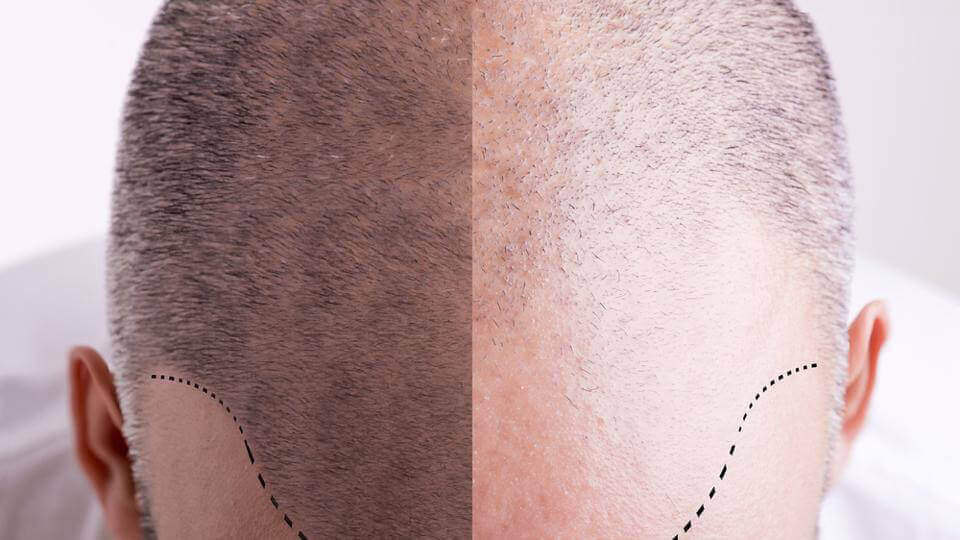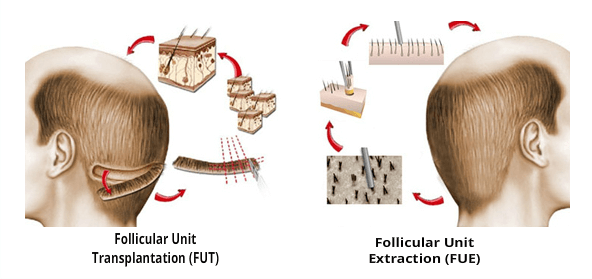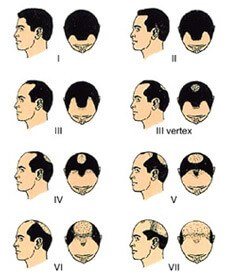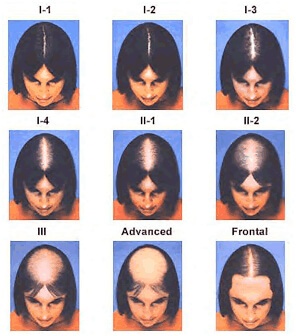

Hair transplant is surgical procedure wherein hair roots are harvested (removed) from the back and/or, sides of the head (in some cases from beard and chest also) and planted in the required area (bald area).
Sides and back of the head are considered a permanent zone that means hairs in these areas are permanent and remain intact life long. Transplanted hairs maintain all qualities of the donor area ( from where hairs were removed), including color, texture, thickness, and life of hair also. So, transplanted hairs are also permanent.

The best donor area of hair roots for hair transplant is head (back and sides), followed by beard and chest in that order of preference.
Indications of hair transplant:
When hair roots are harvested from any part of the body other than scalp (head) example - chest, beard, back, limbs, abdomen and pubic area and transplanted to the bald area of the head, it is known as body to head hair transplant. These hairs are not the first choice but selected when a patient has advanced baldness and hairs in the donor area of scalp and beard are not sufficient to cover the bald area. Growth rate and thickness are less in body hairs as compared to scalp hairs. Hairs from the body should be harvested with FUE technique and not with FUT because the later will leave a significant visible scar at the donor site
Medical treatment is prescribed to prevent hair fall. Treatment of hair fall that is not because of any disease or deficiency but due to androgenic alopecia or male or female pattern hair baldness is described here. Prior to start medical treatment, one must consult a doctor.
It is clear with the above description that all 3 medical options have a different mechanism of action. So when prescribed to use all 3 simultaneously, maximum benefit is achieved.
There are two techniques of hair transplant

FUE is a hair transplantation method which involves taking the individual hair follicular grafts from the back of the head. Follicular grafts are cut one by one through a small specialised machine and are removed. This process is tedious and takes a few hours to complete.
Hair grafts may also be harvested from beard and chest. Procedure is done under local anesthesia. It leaves very small scars, less than a mm. So stitching is not required. Recovery is fast in this method.
FUT is the oldest hair transplant technique in which a thin strip of skin is removed from the back of the head surgically. The hair follicles are then divided into individual units. The donor area is then stitched together.
FUT technique leaves a noticeable scar on the donor area. Hair follicles are implanted by creating reception incisions or holes in the treatment area and placing hair follicles with forceps. Stitches are removed after 10 days.
One can roughly know the required number of follicular units (with type or stage of alopecia in Norwood classification) to get good results with hair transplant.

The Ludwig scale has three primary classifications that display thinning hair, diffuse hair loss, as well as frontal hairline recession. Each image in the scale display a woman’s head with her hair parted down the middle. As an example, images I-1 through I-4 show the progression as a woman goes from no hair loss to increasingly thinning hair as indicated by a widening part. Further along in the scale, the hair loss becomes increasingly drastic. As compared to male hair loss, FPHL is not as wildly expected or accepted in society. Thus, women affected by androgenetic alopecia can experience emotional and psychological distress over their condition. Unlike men, women cannot shave their heads. This scale helps to normalize the condition and provide a point from which to discuss treatment with professionals in the field of hair restoration, dermatology, and other medical professions.

Before selecting a hospital for hair transplant you should know
1. What precautions should be taken before operation?
Smoking should be stopped at least 10days before operation. Do shampoo with betadine scrub night before and on the morning of operation. Have a full breakfast.
2. Is Hair Transplant painful?
Hair transplant is done under local anaesthesia. There is slight pain of needle prick, while giving local anaesthesia. Once anaesthesia is given there is no pain.
3. Is Hair transplant done at a stretch without breaks?
No, patient can take as many breaks as he/she wants. For eg. going to the toilet, taking meals/snacks, can watch movies or listen to music during operation.
4. How long it takes to do Hair Transplant?
It takes about 6 to 9 hours to do 2500 to 4000 follicular units transplant with FUE technique (including all breaks during operation).
5. Is there significant pain after effect of anaesthesia is over?
No, there is slight heaviness in head and in some cases slight pain (especially on the 1st night after operation) that is controlled with tablets.
6. What precautions should be taken after operation?
7. How much time it takes to get good hair growth?
Usually hair growth starts 2 to 3 months after transplanting hair roots (follicular units). Then every month 10% new hair appears. By 6 months hair growth is appreciable and 60-70% hairs are visible. Maximum results are achieved by 10-11 months after operation.
8. Are transplanted hairs permanent?
Yes , transplanted hairs remain for life (as long as hairs are present in the donor area i.e., back and sides of head).
9. Is hair transplant very costly?
No, at Bisoniya hHospital it is very cost effective. Rs 25/FU or Rs 12/ hair + GST. May further consider for non affording/needy patients.
